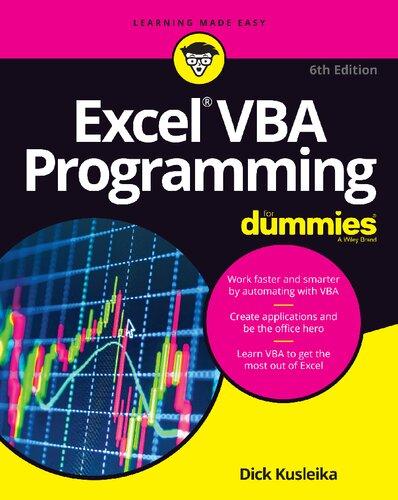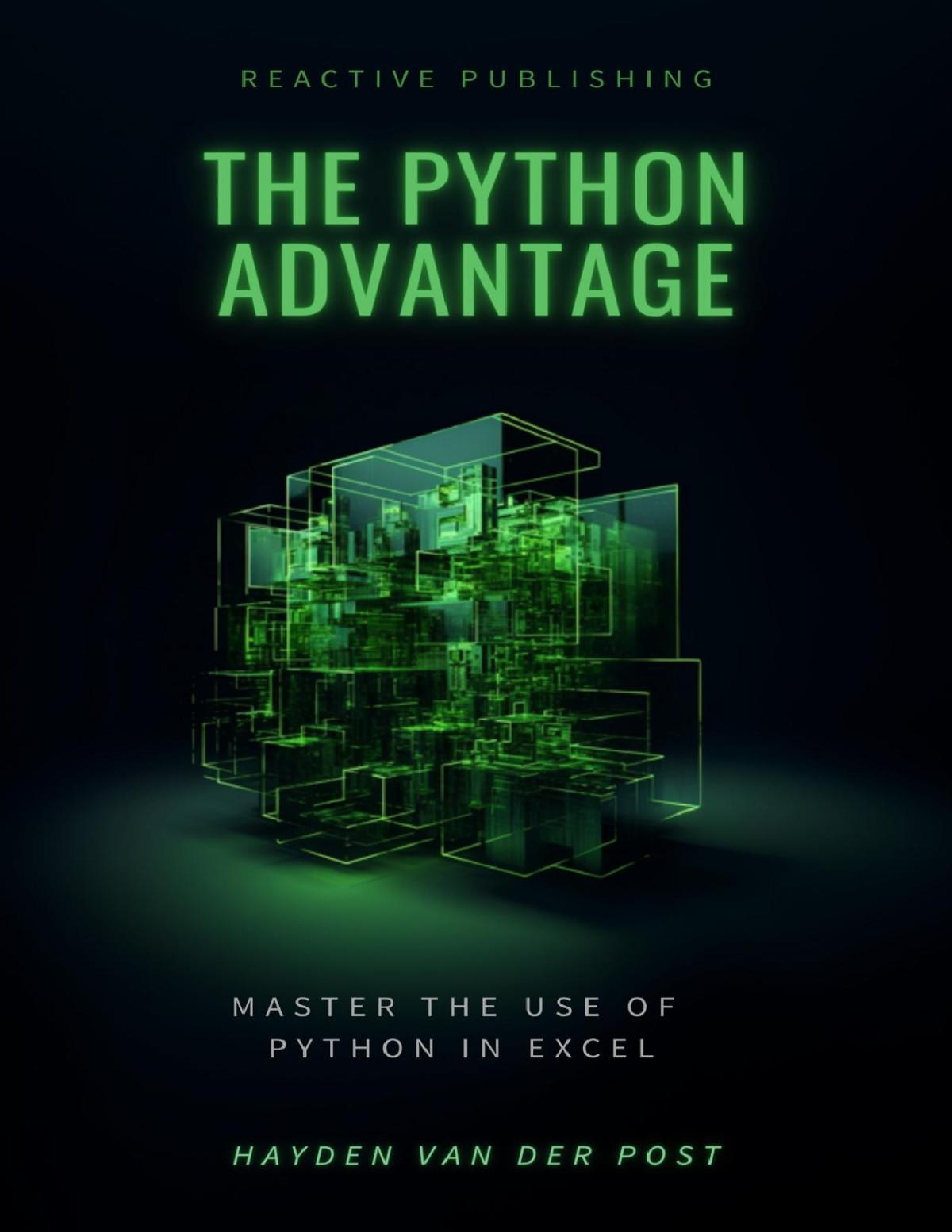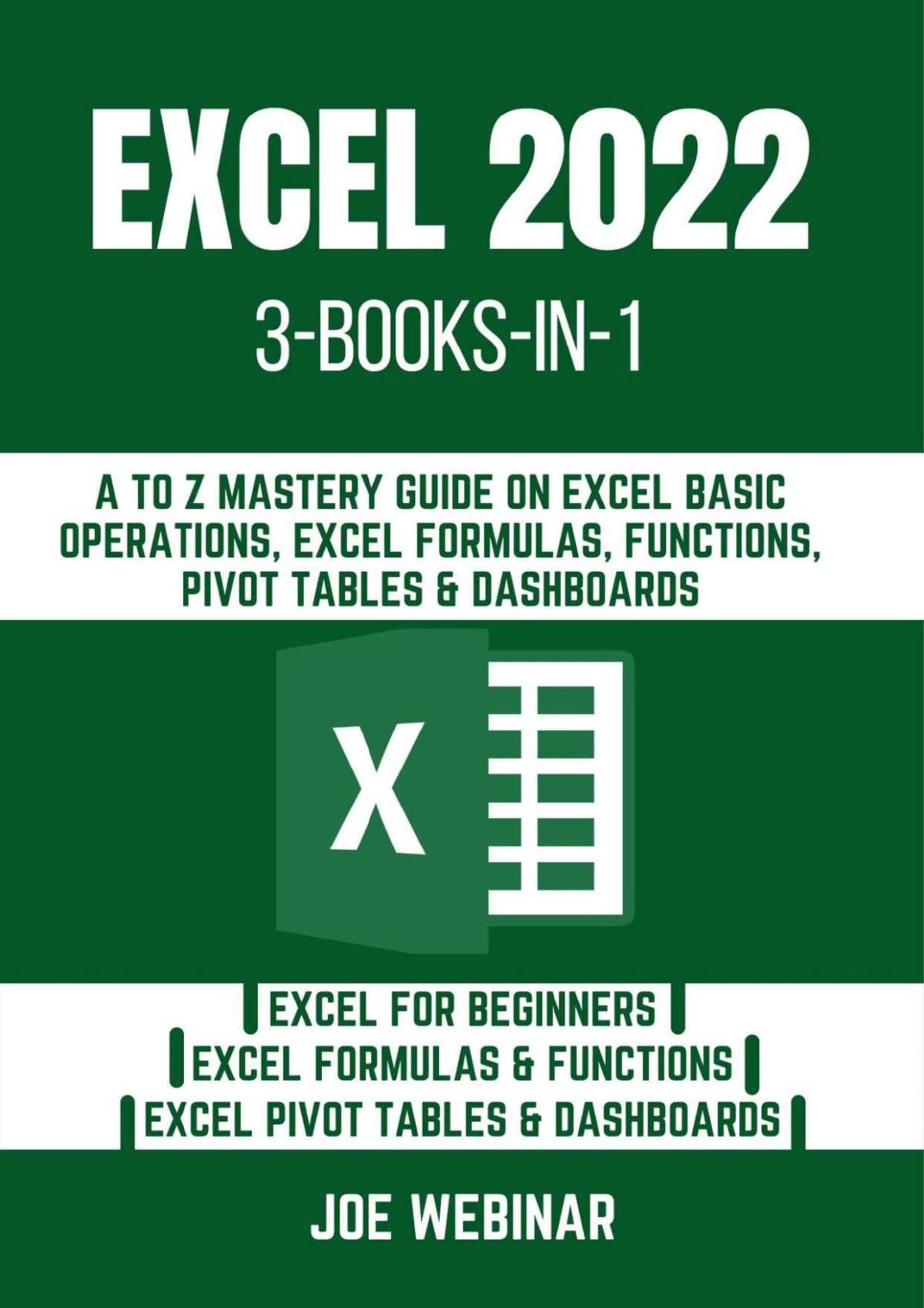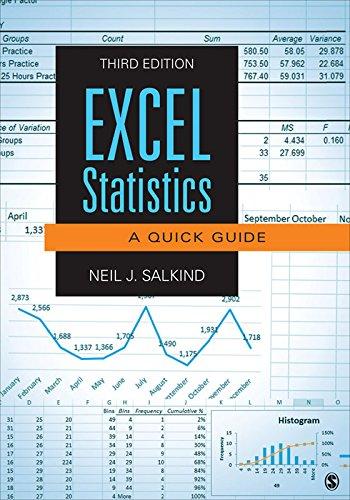Masters of The Universe: Master the Sheets. conquer the data: A Comperehensive Excel Guide Tailored For The Advanced Excel User: Python VBA and More. Sampson
Visit to download the full and correct content document: https://ebookmass.com/product/masters-of-the-universe-master-the-sheets-conquer-t he-data-a-comperehensive-excel-guide-tailored-for-the-advanced-excel-user-pythonvba-and-more-sampson/

More products digital (pdf, epub, mobi) instant download maybe you interests ...

VBA Guru: Master the Art of Automation: A Comprehensive VBA Guide for Finance & Accounting Sampson
https://ebookmass.com/product/vba-guru-master-the-art-ofautomation-a-comprehensive-vba-guide-for-finance-accountingsampson/

The Excel Book Of The Dead: Bring Your Sheets Back To Life Bisette
https://ebookmass.com/product/the-excel-book-of-the-dead-bringyour-sheets-back-to-life-bisette/

Excel VBA Programming For Dummies 6th Edition Dick Kusleika
https://ebookmass.com/product/excel-vba-programming-fordummies-6th-edition-dick-kusleika/

The Python Advantage: Python for excel in 2024 Hayden Van Der Post
https://ebookmass.com/product/the-python-advantage-python-forexcel-in-2024-hayden-van-der-post/

Excel 2022 3 Books In 1: A to Z Mastery Guide on Excel Basic Operations, Excel Formulas Joe Webinar
https://ebookmass.com/product/excel-2022-3-books-in-1-a-to-zmastery-guide-on-excel-basic-operations-excel-formulas-joewebinar/

Statistics for Ecologists Using R and Excel: Data Collection, Exploration,
https://ebookmass.com/product/statistics-for-ecologists-using-rand-excel-data-collection-exploration/

The Essentials of Financial Modeling in Excel: A Concise Guide to Concepts and Methods Michael Rees
https://ebookmass.com/product/the-essentials-of-financialmodeling-in-excel-a-concise-guide-to-concepts-and-methodsmichael-rees/

Excel Statistics: A Quick Guide 3rd Edition, (Ebook PDF)
https://ebookmass.com/product/excel-statistics-a-quick-guide-3rdedition-ebook-pdf/

Make Your Data Speak: Creating Actionable Data through Excel For Non-Technical Professionals 1st Edition Alex Kolokolov
https://ebookmass.com/product/make-your-data-speak-creatingactionable-data-through-excel-for-non-technicalprofessionals-1st-edition-alex-kolokolov/

M A S T E R S O F T H E
U N I V E R S E
An Excel Adventure
Hayden Van Der Post
Josh Sampson
Reactive Publishing


"In the vast universe of data, Excel is not just a tool; it's a compass that guides us through the seas of information. Like thestarsguidingsailorson theirepicvoyages, Excel'sfunctions and formulas illuminate our path, revealing insights and unlocking mysteries hidden in the depths of data. With each pivottablewe create,eachfunctionwe master , we becomenot just analysts, but navigators and explorers, charting courses throughunchartedterritoriesofknowledge.Excelempowers us totransformrawdataintomapsofunderstanding,leadingusto newhorizonsofdiscovery. Inthisjourney, weareallmastersof our universe, turning the complexity of data into the constellationsofwisdom."
JOSH SAMPSON
CONTENTS
Title Page
Epigraph
Introduction
Chapter 1: Excel Introduction
Chapter 2: Getting Started with Basic Excel Functions
Chapter 3: Advanced Formulas and Functions
Chapter 4: Data Analysis and Visualization
Chapter 5: Mastering the Basics of VLOOKUP
Chapter 6: XLOOKUP: The New Frontier
Chapter 7: Diving Deeper with Data Lookup Strategies
Chapter 8: Getting Started with VBA
Chapter 9: Advanced VBA Techniques
Chapter 10: Introduction to Python in Excel
Chapter 11: Working with Python in Excel
Chapter 12: Developing Advanced Automation Solutions
Chapter 13: The PY Function
Chapter 14: Advanced Excel Operations with Pandas
Conclusion
Additional Resources for Excel
Guide 1 - Essential Excel Functions
Guide 2 - Excel Keyboard Shortcuts
Python Programming Guides
Guide 3 - Python Installation
Guide 4 - Create a Budgeting Program in Python
Guide 5 - Create a Forecasting Program in Python
Guide 6 - Integrate Python in Excel
INTRODUCTION
Greetings and a grand welcome, my friends, to the majestic realm of "Masters of the Universe" a guide as rich and layered as the ancient forests of British Columbia. As a scribe nestled in the heart of Vancouver, where creativity flows like the mighty currents of the Fraser River, I beckon you to embark on an odyssey through the art of Excel, akin to a valiant trek through the towering peaks of the Coast Mountains.
Envision yourselves not as fleeting tourists capturing hurried snapshots of the Capilano Suspension Bridge, but as true Vancouverites, sipping robust coffee in a snug café, delving into the mysteries of Excel with the precision of master craftsmen shaping the skyline with cutting-edge architecture.
In this city of diverse boroughs, where each neighborhood boasts its unique spirit, Excel too weaves its own tales. Picture VLOOKUP as a savvy Vancouverite, navigating the city's seamless SkyTrain network, effortlessly linking various data points with the efficiency of a seaplane skimming across English Bay.
As you turn each page, see it as traversing the rugged trails of Stanley Park, where every turn unveils a new vista, a new piece of natural history. Here, in the world of spreadsheets, you'll unearth the
secrets of Excel, as thrilling as uncovering a hidden gem in the heart of Granville Island.
So, my friends, let us raise our glasses (or coffee mugs) in a toast to the adventure that beckons. With "Masters of the universe" as your compass, you are not mere Excel users; you are architects, sculpting data with the same innovation that defines Vancouver's tech landscape. Welcome to your journey of Excel mastery, Vancouver style!
To your triumph and exploration!
Hayden

CHAPTER 1: EXCEL INTRODUCTION
As the first light of dawn casts its glow on the glassy surface of Vancouver's English Bay, reflecting off the modern skyscrapers and touching the ancient rainforests, a small café in the heart of Gastown comes to life. Here, local visionaries and creators converge, amidst the symphony of espresso machines and the murmur of early conversations. In this haven, a young entrepreneur named Emily opens her laptop, revealing a complex world of numbers and charts in her Microsoft Excel workbook.
Emily, with the poise of a seasoned strategist in the midst of an epic battle, begins her daily quest through the realms of data. To her, Excel is the Fraser River of business, a vital artery that courses through and unites all aspects of her venture. Just the day before, Emily found herself navigating a flood of data, analyzing her startup's financial health. Her task: to present this data to potential investors in a manner as mesmerizing as the vistas from Stanley
Park, yet as precise and structured as Vancouver's grid-like city layout.
With her artisanal coffee in hand, Emily reflects on the moment Excel's true potential was revealed to her. It was during a visit to the vibrant Granville Island Public Market, a kaleidoscope of local crafts and flavors. Amid the eclectic stalls and artistic vibrancy, she came across an old, detailed map of Vancouver. This map, with its web of streets and waterways, was a revelation, akin to an intricate Excel spreadsheet. It was then that Emily understood Excel's magic – like the map provided a guide through Vancouver's diverse neighborhoods, Excel charted a course through layers of data. It became her compass, navigating financial forecasts, customer trends, and market analysis, transforming a deluge of data into a clear stream of insights and opportunities.
Back in the café, Emily's face lights up with satisfaction as she completes her presentation. She's turned a chaotic array of numbers into a compelling narrative, akin to the way a bard might recount tales against the backdrop of the majestic Lions Gate Bridge. Closing her laptop, she feels a surge of triumph. For Emily, Excel is more than a tool – it's an ally in her entrepreneurial journey, a bridge from vision to reality.
Stepping onto the cobblestone streets of Gastown, ready to face the challenges of the day, Emily carries with her the assurance that her Excel spreadsheets are her armory. In the bustling heart of Vancouver, amidst its fusion of nature and urban innovation, Excel stands as a vital tool in the art of business, as indispensable to entrepreneurs as the mighty Fraser is to the landscape of British Columbia.
Excel, in its dynamic digital environment, continues as a paragon of adaptability. The introduction of Excel marks a significant shift in data handling and analysis capabilities, presenting a revolutionary
stride in the software's evolution. This iteration demonstrates a substantial advancement, offering a suite of tools that adeptly serve both beginners and expert analysts. Our journey dives into the user interface of Excel, which is meticulously crafted to optimize efficiency and elevate the user experience in data-related tasks.
At the heart of Excel in 2024 is a user experience that is both intuitive and empowering. Users are greeted by a sleek, modern interface that simplifies navigation while providing rapid access to a suite of sophisticated tools. The ribbon menu, a hallmark of Excel's design, has been meticulously refined to present functionality that's relevant to the task at hand, reducing clutter and focusing on user efficiency.
But it's not just about looks—Excel is smarter too. The integration of artificial intelligence is no longer just a buzzword; it's a reality that's palpable in every aspect of the software. With AI-driven insights, Excel proactively suggests actions, helping users make sense of their data with ease. From forecasting trends to detecting anomalies, the intelligence embedded within Excel is a game-changer for data analysis.
Furthermore, Excel revolutionizes the way we interact with data through its enhanced collaboration tools. The program has been engineered for seamless integration with the cloud, enabling teams to work concurrently on documents, share insights in real-time, and ensure that their work is always accessible, secure, and up-to-date.
Excel also boasts a more robust set of data visualization tools. The new dynamic array functions and XLOOKUP feature enhance the user's ability to sort, filter, and present data in a way that's both compelling and informative. By reducing the complexity of formulae and offering an array of chart types and styles, Excel makes advanced data representation accessible to all users.
Exploring Excel in 2024 reveals Microsoft's focus on enriching user experience, boosting efficiency, and broadening the analytical potential of its leading spreadsheet application. This segment provides an in-depth examination of the groundbreaking features distinguishing Excel from earlier versions. It highlights how users are empowered with advanced tools designed to navigate and address the intricacies of contemporary data analysis challenges effectively.
One of the standout additions to Excel is the Predictive Typing feature. This AI-powered tool anticipates the user's input based on context and patterns in their data, allowing for faster and more efficient data entry. It significantly reduces the time spent on manual input, especially when dealing with repetitive data, which is a common occurrence in spreadsheet management.
Another significant advancement is the Real-time Collaboration suite, which takes teamwork to the next level. Unlike previous versions where collaboration was possible but sometimes laggy, Excel introduces a truly synchronous environment. Users can now see each other's selections, edits, and comments in real-time, without experiencing delays or having to refresh their sheets. This feature is invaluable for remote teams who depend on timely and accurate data sharing.
Excel also introduces Advanced Data Types, expanding beyond text and numbers to include types like stocks, geography, and even custom objects. These data types are linked to live online data, allowing users to incorporate real-world data into their spreadsheets effortlessly. For instance, one can now easily track stock market trends or demographic changes without leaving Excel or sourcing data from external databases.
In response to the growing need for better data visualization, Excel has introduced Dynamic Data Visualizations. These are not just mere static charts; they are interactive and can update in real-time as
data changes. Users can now create more engaging reports that tell a story through their data, making it easier to spot trends, patterns, and outliers.
Furthermore, Excel has redefined how we approach complex calculations with the introduction of Lambda Functions. These allow users to define custom functions using Excel's formula language, effectively creating reusable components within their spreadsheets. This feature empowers users to build more sophisticated calculations without the need for VBA scripting, simplifying formula management and reducing errors.
Lastly, Excel has made strides in accessibility with the Seamless Accessibility Checker. This tool ensures that spreadsheets are designed with inclusivity in mind, offering guidance on how to make data accessible to users with disabilities. It checks for issues like color contrast, screen reader compatibility, and ease of navigation, ensuring that spreadsheets are not just powerful, but also universally accessible.
Each of these features represents a leap forward in spreadsheet technology, and in the coming sections, we will explore how they can be applied in practical, real-world scenarios. From streamlining everyday tasks to unlocking the full potential of data analysis, Excel is a tool that reimagines productivity and sets a new standard for what's possible in data management.
System Requirements and Installation
Starting your experience with Excel requires preparing your system to support its novel features and the comprehensive functionalities it brings. This part thoroughly details the system prerequisites needed for the smooth operation of Excel. It also includes a detailed, stepby-step walkthrough for an effortless installation, ensuring your
system is fully equipped to leverage the software's advanced capabilities.
To operate Excel, users must have a system equipped with a minimum processor speed of 1.6 GHz, although a faster multi-core processor is recommended for optimal performance, especially when dealing with large datasets or complex calculations. The software requires a minimum of 4 GB RAM for the 32-bit version and 8 GB RAM for the 64-bit version, with additional memory beneficial for enhancing responsiveness and multitasking capabilities.
The hard disk space required for installing Excel stands at a minimum of 4 GB. However, for those planning to utilize additional features, such as advanced data models or extensive macro libraries, allocating more space would be prudent. As for the operating system, Excel is compatible with the latest versions of Windows and macOS, ensuring cross-platform functionality.
Graphics hardware acceleration necessitates a DirectX 10 graphics card, and a display resolution of at least 1280 x 768 is required to appreciate the refined user interface and intricate visualizations offered by Excel. Additionally, users must have a touch-enabled device to utilize any touch features, though these aren't mandatory for running the software.
A functional internet connection is another critical requirement, not only for the initial download and installation but also for accessing Excel's live data types and real-time collaboration features. Users must also possess a Microsoft account, which is integral to activating the software and syncing preferences across devices.
1. Run the installation package and enter your product key when prompted.
2. Agree to the terms and conditions to proceed with the installation.
3. Choose your installation preferences, including the destination folder and any optional components you wish to include.
4. The installer will then download the necessary files and install Excel on your system. An internet connection is crucial during this step to ensure all components are downloaded correctly.
5. Once the installation is complete, launch Excel and sign in with your Microsoft account to activate the software.
The installer also includes an Accessibility Checker to ensure that your system settings are optimized for users with different needs. This feature helps tailor your Excel environment to accommodate visual, auditory, or mobility impairments, reinforcing the commitment to inclusivity.
To verify a successful installation, users can open Excel and navigate to the "Account" section under the "File" tab, where the software's activation status and version details will be displayed. If any issues arise during the installation, the Excel support team is available to assist with troubleshooting, ensuring a smooth transition to the newest iteration of this essential productivity tool.
With your system properly set up and Excel installed, you are now ready to explore the horizons of data analysis, equipped with a powerful tool designed to meet the demands of the future.
Customizing the User Interface
Upon initiating Excel, the default UI presents a clean and intuitive layout that serves as a canvas for your personalization journey. The ribbon, which houses tabs and commands, is the centerpiece of customization. You can modify the ribbon by adding or removing tabs, as well as creating custom tabs with a selection of commands that align with your frequently used tasks.
1. Right-click on any part of the ribbon and select 'Customize the Ribbon...'.
2. In the 'Customize the Ribbon' window, you can create new tabs by clicking 'New Tab' and dragging commands from the list on the left to the new tab on the right.
3. You can also reorder tabs and commands by selecting them and using the arrow buttons to move them up or down.
4. Once satisfied with your custom ribbon, click 'OK' to apply the changes.
Another aspect of the UI that can be personalized is the Quick Access Toolbar (QAT). Located above the ribbon, the QAT provides swift access to commands, irrespective of the tab you are currently on. Customizing the QAT is similar to the ribbon and involves adding or removing commands to suit your workflow.
1. Click on the small downward arrow at the end of the QAT and select 'More Commands...'.
2. In the 'Quick Access Toolbar' settings, choose commands from the list on the left and add them to the QAT on the right.
3. Adjust the order of commands by selecting and using the arrow buttons, then click 'OK' to finalize your QAT setup.
Furthermore, Excel allows users to modify the theme and background of the application. By navigating to the 'Account' section under the 'File' tab, you can select from various themes and backgrounds, which change the overall look and feel of the Excel environment, from the color scheme to the imagery behind the workspace.
1. Clicking on 'File', then 'Account'.
2. Under the 'Office Theme' dropdown, choose your desired theme to change the color scheme of the interface.
3. Under 'Office Background', select a pattern or image to add a personal touch to the top-right corner of your Excel window.
Excel also offers advanced options for UI customization, including the ability to enable or disable animations and feedback sounds. These settings can be accessed via 'Options' under the 'File' tab, where you can navigate to 'Ease of Access' and 'Advanced' settings to make the desired adjustments.
By customizing the user interface in Excel, you create a personalized workspace that aligns with your unique needs and preferences. This not only enhances your experience with the software but also streamlines your workflow, allowing you to focus on the data analysis tasks at hand with greater efficiency and less distraction. With these customization tools, Excel adapts to you, ensuring that your interaction with the software is as productive and enjoyable as possible.
Understanding the Workspace
The workspace in Excel is a harmonious blend of functionality and design, aimed at enhancing the user's interaction with data. In this section, we delve into the elements that compose the Excel workspace, ensuring you can navigate and utilize its features to the fullest extent.
At first glance, the canvas of Excel may seem familiar, but beneath the surface, there are nuanced enhancements that await your exploration. The workspace is meticulously organized into several key areas: the ribbon, the formula bar, the status bar, the worksheet view, and the task panes. Each component is integral to the user's journey through data manipulation and analysis.
The Ribbon: The ribbon remains a cornerstone of Excel, housing an array of tabs and commands. In Excel, the ribbon is context-
sensitive, dynamically adjusting to display the tools most relevant to the task you are performing. Whether you are formatting cells, crunching numbers, or visualizing data, the ribbon anticipates your needs, presenting a curated set of functionalities for immediate access.
The Formula Bar: The formula bar in Excel has been enhanced to offer more than just a space to enter and edit formulas. It now provides intelligent suggestions and auto-completes features as you type, learning from your patterns of use to streamline your workflow. The formula bar also offers a resizable interface, allowing you to view and edit longer formulas with ease.
The Status Bar: Situated at the bottom of the Excel window, the status bar is an information hub that displays key insights about your current selection or the entire worksheet. It has been refined to include customizable data summaries, such as average, count, or sum, which you can choose based on the context of your work.
The Worksheet View: The heart of Excel, the worksheet view, is where data comes to life. Excel introduces new ways to visualize and interact with your data, including enhanced zoom capabilities and smooth scrolling to navigate large datasets efficiently. Additionally, new data types and dynamic arrays are visually distinct, making it easier to identify and manage different segments of your data.
Task Panes: Excel's task panes are dockable windows that house tools for specific functions, such as selection pane, clipboard, or insights pane. These can be opened or closed as needed, offering a flexible workspace that adapts to the complexity of your tasks. The task panes can be repositioned within the workspace to suit your preferences, ensuring that the tools you use most are always within reach.
The design philosophy underpinning the Excel workspace is to provide a seamless and intuitive environment that empowers users to focus on their data rather than the mechanics of the software. By understanding the layout and capabilities of each workspace component, you can harness the full potential of Excel, crafting data narratives with precision and creativity.
As you become accustomed to the Excel workspace, let it become an extension of your analytical thought process. The fluidity with which you can mold and interrogate data is a testament to the power of a well-orchestrated workspace—a space where insights emerge with clarity and decision-making becomes a product of informed intuition.
Navigating through Menus and Ribbons
Firstly, the File menu, also referred to as the Backstage view, is your gateway to managing your Excel files. From here, you can engage in a variety of file-related activities such as creating new workbooks, opening existing projects, saving and exporting data, printing sheets, and managing account settings. Excel's Backstage view has been crafted to provide quick access to recent files and folders, making it easier to pick up where you left off.
The Home ribbon, perhaps the most frequented of all, houses a plethora of tools for daily tasks. It is here that you can cut, copy, paste, and format data to your heart's content. The cells group within the Home ribbon provides swift access to insertion, deletion, and cell format adjustments. Moreover, the number group presents options to define the data type, whether it be currency, date, percentage, or custom formats.
The Insert ribbon unlocks the potential to embellish your worksheets with tables, charts, illustrations, and links. The addition of Sparklines, miniature charts that fit within a single cell, allows for a quick graphical representation of data trends. Excel further enhances
the Insert ribbon with new types of charts and an easier interface for incorporating multimedia elements, making your data presentation more impactful.
For those who delve into complex data analysis, the Formulas ribbon is a treasure trove. It categorizes functions into logical, financial, text, date and time, lookup and reference, and more. The newly introduced 'Function Library' is an intuitive feature that helps you find the right formula for your data analysis needs, complete with examples and usage explanations.
The Data ribbon is where data becomes dynamic. It offers tools for sorting and filtering, importing external data, and defining data ranges. With Excel, this ribbon has been optimized to handle large datasets more efficiently, and it integrates seamlessly with Power Query and Power Pivot, offering advanced data modeling capabilities.
Reviewing your work is made effortless with the Review ribbon, which includes spelling check, comments, and tracking changes. Excel's collaborative features are also accessed here, with enhanced sharing options that facilitate teamwork and collective data management.
The View ribbon provides control over the visual aspect of your workspace. It allows you to switch between Normal, Page Layout, and Page Break views, freeze panes for easy navigation, and arrange multiple open workbooks for comparison.
Lastly, the Developer ribbon, often hidden by default, is where you can access powerful tools for building applications within Excel. This includes Visual Basic for Applications (VBA), macros, and add-ins. The Excel version offers a more user-friendly approach to these advanced features, making automation and customization more accessible to users with varying levels of technical expertise.
Navigating through Excel's menus and ribbons is a journey through a landscape of data manipulation possibilities. Each ribbon is meticulously designed to cater to specific aspects of your workflow, ensuring that the tool you need is never more than a few clicks away. As you grow familiar with these controls, you will find that they are not just a means to an end but a powerful ally in your quest to unlock the full potential of your data.
Introduction to Templates
Templates in Excel are akin to blueprints for efficiently constructing a robust dataset or report—they are the starting blocks from which all manner of projects can be launched. In this section, we will guide you through the intricacies of Excel templates, exploring how they can serve as both time-savers and foundational frameworks for your data-driven narratives.
The essence of a template lies in its pre-structured nature. Excel offers a diverse library of templates, each tailored to specific tasks such as budgets, calendars, invoices, and project timelines. These templates are designed not just to provide a format but also to exemplify best practices in layout and function. They are meticulously crafted to ensure that you, the user, can focus on inputting data rather than concerning yourself with the setup.
Getting started with templates is straightforward. Upon launching Excel, the 'New' tab presents you with a variety of categories. Each category houses templates that cater to different industries and personal needs. For instance, a 'Financial Management' category might offer templates for expense tracking, while a 'Data Analysis' category could present you with pre-constructed models for statistical evaluation.
One of the standout features of Excel templates is their customization capability. While a template may come with pre-set
formulas, styles, and formatting, these elements are not set in stone. They are fully editable, allowing you to tweak them to suit the unique contours of your project. This flexibility is crucial as it empowers users to inject personal flair into their work, ensuring that the final product resonates with their vision.
Excel also simplifies the creation of your own templates. This can be particularly useful for repetitive tasks specific to your workflow. For example, if you regularly produce monthly sales reports, you can create a template that includes your preferred chart styles, formulas for calculating totals or commissions, and your company's branding. Once saved, this template becomes an asset that can be reused and shared with colleagues, streamlining the report generation process.
Moreover, Excel introduces intelligent templates that leverage the power of AI. These templates can suggest data types based on the input and offer dynamic charts that update in real-time as data changes. The integration of such smart features means that your templates not only serve as static frameworks but also evolve as living, responsive documents that reflect the current state of your data.
The templates in Excel also promote collaboration. With cloud integration, teams can access and work on shared templates simultaneously, from anywhere in the world. Changes are synchronized in real-time, ensuring that everyone is always working with the most up-to-date information. This feature is invaluable for teams that operate across different time zones or when remote work is involved.
Templates in Excel are more than mere placeholders for data; they are sophisticated tools designed to enhance productivity and inspire creativity. As you delve into the world of templates, you'll discover that they are instrumental in shaping the way you approach data organization and presentation. They are not just about saving time;
they are about elevating the quality and coherence of your work. Whether you choose to utilize pre-made templates or craft your own, the journey into Excel's templating capabilities is sure to enrich your experience with this powerful software.
Saving and Exporting Options in
In the digital age, data is fluid, and its true value is realized when it's shared and utilized across platforms. Excel facilitates this by offering a suite of saving and exporting options that cater to various needs and scenarios.
Excel introduces enhancements in the way you can save files, ensuring that your data is not only secure but also easily accessible when and where you need it. The traditional 'Save As' feature has evolved, now offering integrated cloud storage options. With a simple click, your files can be saved directly to OneDrive or SharePoint, enabling automatic syncing across all your devices. This seamless connectivity guarantees that the latest version of your work is always at your fingertips, fostering a more dynamic and flexible working environment.
The 'AutoSave' feature is another crucial development that has been refined in Excel. It works silently in the background, continuously saving your progress as you work. This feature can be a lifesaver, particularly during long and intense data manipulation sessions where the risk of data loss due to an unexpected interruption is ever-present. With 'AutoSave', your efforts are preserved, providing peace of mind as you delve into your analytical endeavors.
Exporting data is just as pivotal as saving it. Excel retains its ability to export worksheets and workbooks to a variety of formats, including the ubiquitous PDF and the classic CSV file. However, it goes a step further by introducing new formats designed to facilitate better data interchange with other applications. For example,
exporting to JSON format is a breeze in Excel, which is a boon for users who work with web applications and services that consume JSON data.
For those in the realm of data science and analytics, the ability to export directly to a Python-friendly file format is a game-changer. Excel allows you to quickly export your data to .py files, enabling immediate use in Python scripts without the need for additional data wrangling. This feature not only saves time but also opens up a myriad of possibilities for utilizing advanced analytical techniques that are native to Python.
Collaborative work environments require flexibility in sharing documents, and Excel delivers just that. With improved export functionality, you can now share a link to your workbook that grants either view or edit permissions to colleagues. This ensures that collaborators can access the most current data without the need to send attachments back and forth, streamlining the collaborative process and reducing the risk of working on outdated information.
Finally, Excel takes into account the need for privacy and security when exporting data. It offers robust options to protect sensitive information, such as password protection and the ability to restrict editing or copying. When exporting data that includes confidential or proprietary information, these security features are indispensable, ensuring that your data remains protected even when it leaves the safety of your personal storage space.
In summary, the saving and exporting options in Excel are designed to accommodate the modern data professional's need for versatility, security, and ease of use. As you become acquainted with these options, you'll find that they not only streamline your workflow but also provide you with greater control over how your data is stored, shared, and ultimately leveraged for success.
